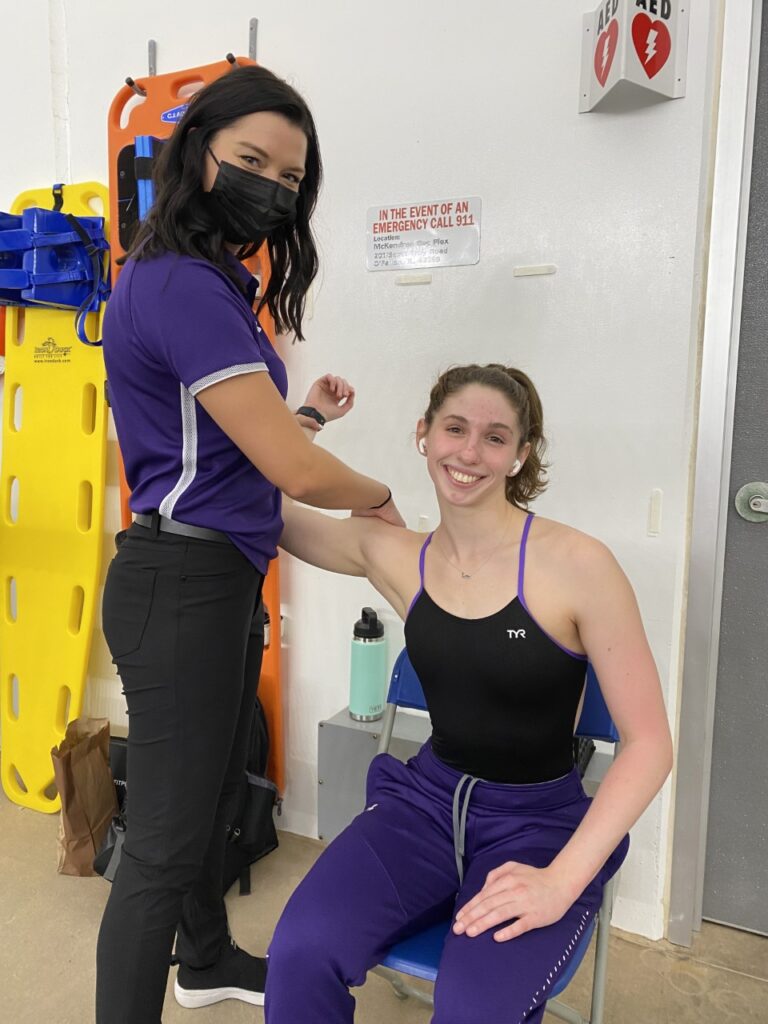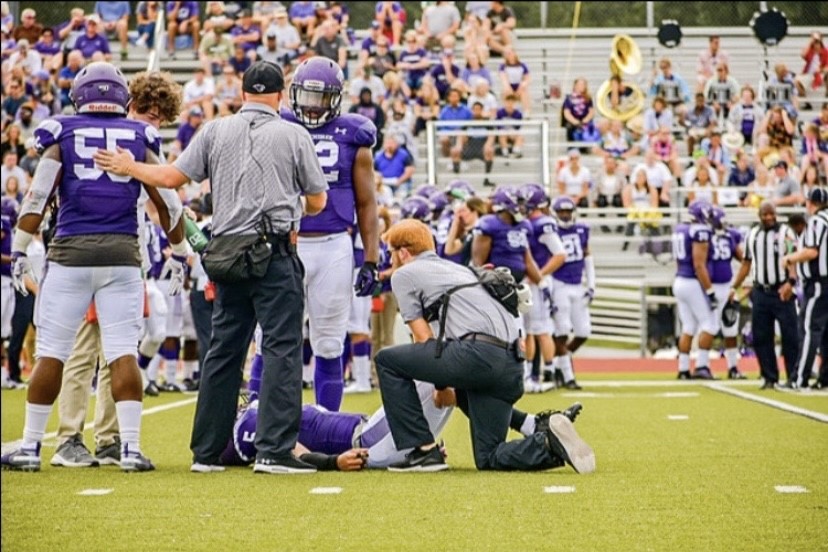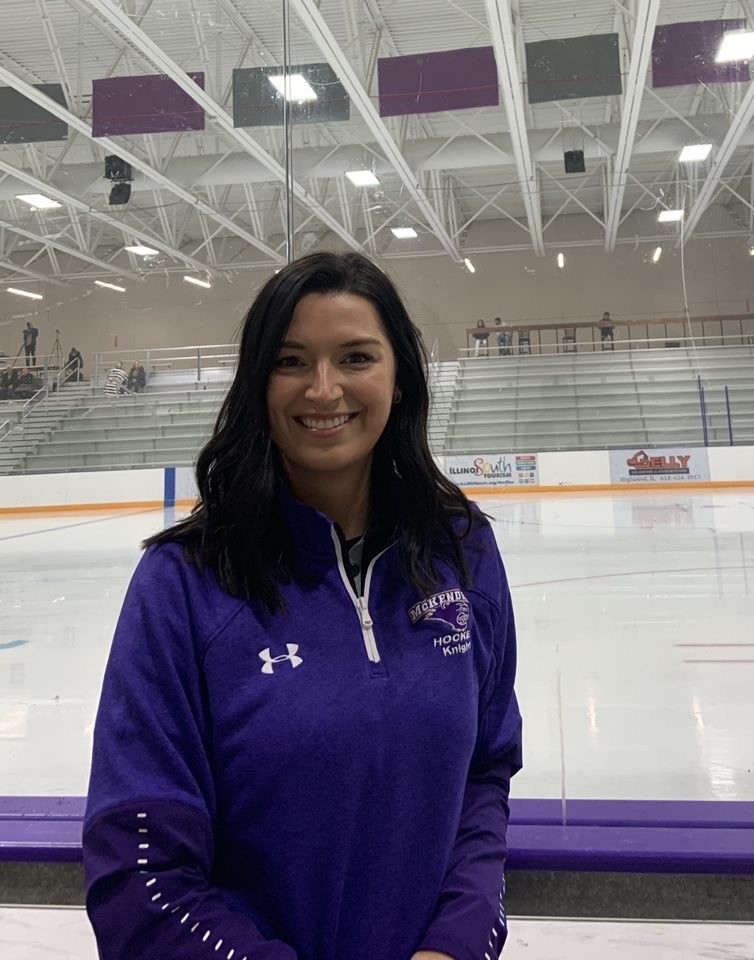
By Haley Rey, Editor in Chief
Photos from Haley Rey, Phoebe McCutcheon, and McKendree University
It’s no secret that the majority of students at McKendree belong to a sports team. With 36 teams, there are hundreds of hours poured into training each week. Coaches take care of their athletes in plenty of ways, but the credit for keeping the bodies of athletes in a competition-ready condition—or helping to heal them from injury—belongs to the school’s athletic trainers.
Chloe Knight works with Men’s and Women’s Hockey, Men’s and Women’s Swimming and Diving, and Men’s and Women’s Water Polo at the McKendree Metro RecPlex. She works both practices and events for all teams, dividing up hours with trainer Brooke Buchmueller.
“I would say I work—on average—between 40-50 hours per week on paper, anywhere from 8-12 hours a day at times, depending on practice/competition schedules for my teams,” says Knight. “For example, this past Friday I worked a swim meet and hockey game back-to-back, putting in a roughly 13-hour day.”

Mike Doerr works with Women’s Lacrosse, Track and Field/Cross Country, and Football on campus. He also works practices and events for the teams he is responsible for, along with other ATs. He works an average of 55-65 hours each week.
Athletic training is not very well understood by those not closely affiliated with college or professional athletics. The main aspects of the job are not as simple as many may assume.
Knight explains, “Athletic training is a multidimensional healthcare profession. I feel as if we are the jack of all trades in the healthcare world. We focus on preventative care, emergency care, clinical evaluation and diagnosis, treatment, and rehabilitation of orthopedic injuries.
A typical day includes pre and post practice prep (water, taping, treatments, etc.), injury rehab, and watching practices”
Doerr adds, “We treat and care for student athletes. This includes immediate care, acute and chronic injuries, rehabilitation, prevention, and illnesses.”
The job poses many challenges, since the trainers care so incredibly much about their athletes. Helping athletes becomes a trainer’s entire life, and it’s difficult to ignore the connection that grows between trainers and the students they care for.
“The hardest part of my job is breaking negative news on injuries to athletes and coaches, especially when it’s about season-ending injuries,” shares Doerr.
For Knight, the toughest part of the job is creating a work-life balance. “It is sometimes hard to be able to compartmentalize with work and off time,” she says. “We dedicate our lives to caring for others and it becomes hectic at times. I feel that because of this, ATs often miss out on important family functions or even holidays due to having to work, but the emotional toll it takes on us is still present when we come home with our minds still thinking about the day, wondering if our athletes are doing okay. I have personally been working on coming home and detaching myself from any work communications that can wait until the following day.”

Despite the challenges, Chloe and Mike appreciate the rewarding feelings from their jobs.
“I feel it is most rewarding when we feel we are making a difference,” Knight explains. “I have held on to every sticky note, thank you card, and memory of times athletes have expressed gratitude for any help I provided. I can remember moments following an athlete’s long, hard road following a rehab back from an injury and proving that they came back into the sport ‘bigger, faster, and stronger.’ Athletes are able to remind me daily why I do what I do, without even realizing it.”
Doerr also finds fulfillment working as a trainer. “I find my job very rewarding; I love helping my athletes with anything,” he says. “It’s very rewarding to get an athlete back from a surgical procedure and back to the sport they love. It’s also rewarding to me when I build trust in my athletes, and they know they can come to me with anything and feel secure speaking to me.”
One of the more interesting parts of the job is travelling with teams when they compete off-campus. Some teams travel more than others, visiting places as far away as California.
Doerr shares, “I travel with Football and Women’s Lacrosse anywhere they go, typically every other weekend. I do enjoy traveling at times, depending on the location we are traveling.”
Knight also travels with her teams: “In a normal year/season, I travel to every away event with high-contact sports, and post-season with all teams if scheduling allows. I do enjoy traveling; I feel it is a good time to spend with one team at a time and to get to know my athletes a little better.”

Athletic training is such an important job, especially at a school that recruits so strongly through sports. There is, however, still far too much misunderstanding about the occupation, even among the teams that benefit from trainers’ hard work.
“I genuinely wish people understood how much we really care about our athletes, sometimes to the point where it becomes physically and emotionally draining,” says Knight. “We often put work and our athletes before our own well-being.”
“I wish athletic training was more known in the public,” adds Doerr. “I wish we were recognized and respected as healthcare providers and not just sideline water support.”
While not all athletes get regular treatment, there are plenty that recognize how beneficial it is to have an AT available to help them.
Camryn Anderson, a senior on the Women’s Swim Team, says, “Chloe has helped me through more than just injuries or treatment. Chloe is there for me whenever I need anything, mentally or physically—I can go to her at any time. She is a valued member of the Swimming and Diving team; without her, our team would not be performing the way we do.”
Kat Albrecht, a senior on the Women’s Lacrosse team, shares, “Mike is the best trainer we have had! He cares about our well-being, checking in on us during practice while providing us the best care for our injuries or tight muscles. Also, if our bodies are extra sore, Mike will make sure the couch pulls us back a little bit.”
Clearly, there is a lot of work in being an athletic trainer. However, how much work does it take to simply become an AT? What hard work happens before the big challenge of the job itself?

Sydney Rey, an alumna from McKendree, just finished her masters program in athletic training and took her boards earlier this month.
“It’s a five-year program,” says Rey. “The first three years consist of an undergraduate program with an exercise science background, and the last two years are for the athletic training classes (including summer courses). The overall process includes applying for the program, writing an application MSAT essay (and why they should let you in the program type of essay), and actually completing the degree.”
Rey continued, “There are three sides to becoming an AT. You have to complete and graduate from an accredited program, pass the national board of certification for athletic trainers, and be a member of the National Athletic Trainers Association. After passing and completing everything, you can become an AT.”
One of the most taxing parts of the process is taking the board exam. Rey spent over six weeks studying, for five to seven hours per day, leading up to her test.

“Preparing for my boards was a particularly difficult experience—one of the hardest in my life—because they were postponed two different times, which made for a hard and irregular study pattern,” says Rey. “There’s so much information to know and we’re only asked 175 questions on the test. There are five domains that each make up a different percentage of the test, and we are not told which questions are scored and which ones are not. It was even more difficult because I had a lot of things I needed to learn on my own; COVID-19 compromised our learning in the classroom with various quarantines. When studying, I only took one day off each week, if that.”
The motivation for Rey to become an AT came from personal experience as an athlete.
“I wanted to be an AT because I had five surgeries throughout my college swimming career and I know what it’s like to have to come back from an injury,” she explained. “I want to help other athletes return to the sport they love as soon as they can, in the same or better condition than before the injury.”
With just a few more weeks to go before receiving her results, Rey looks forward to finally becoming an AT after having to wait so long. She’s a great example for aspiring athletic trainers to look up to.
She explains, “If I could say anything to future AT students, it would be to always ask questions and understand that you’re going to make mistakes, and that’s okay! That’s how you become a better AT.”
Becoming an athletic trainer and being on the job are two very difficult processes, and the work is incredibly important to the structure of college and professional athletics. Where would we be without our trainers?